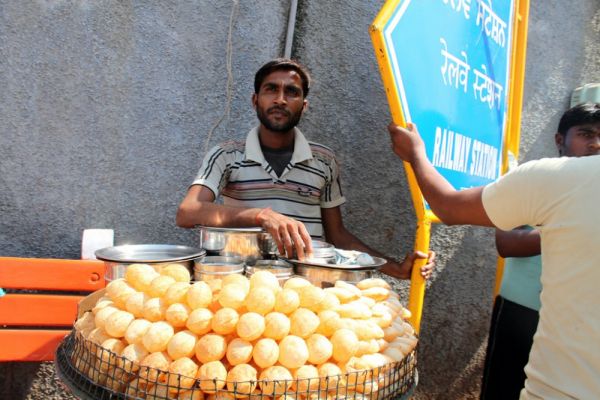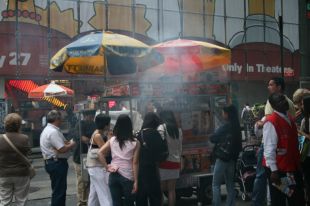The Big Question: How Can We Reconcile Street Vending With Pedestrian-Friendly Sidewalks?

Photo by flowcomm via Flickr Creative Commons
They’re a critical pillar of the informal economy, but as street vendors multiply, the amount of sidewalk space available for pedestrians is shrinking. The issue of how to make room for such vendors — if at all — is becoming an urgent and controversial issue that cities must face. Below, three perspectives on how to equitably share the pavement.
The City of the Future Will Be a “Market City”
By Ethan Kent
How can cities keep their sidewalks pedestrian-friendly while still allowing informal street vendors to make a living?
The negative perception of informal vending is an issue that plagues cities everywhere, but the successful integration of such vendors can add to the lifeblood of a thriving city.
Unfortunately, many cities don’t have a vision of a positive role for vending. Around the world we are removing street vendors and razing market districts where vendors compete to contribute to a shared public experience. We are often replacing them with internalized retail that merely sucks value from its location near pedestrian flows. Often under the auspices of planning for mobility, economic development, or “world-class design,” we create cities that preclude this most fundamental scale of economic activity.
As we plan for the Western ideals of accommodating maximum throughput of various transportation modes, maximizing retail rents and leading with design and branding concepts, we forget the more central purpose of transportation systems and streets: They create places where people want to be. The best streets blur the public and private, transitory and stationary activities, while being anchored in usually informally communicated public goals.
As we have disinvested in, and often disparaged, these self-managed spaces, the same businesses have been forced into a mode of marginalization and/or survival.
The number of street vendors in Bangkok has soared over the past two decades. Here, our six-minute film chronicles the attempts of two of them to thrive in the informal economy.
Cities first formed as informal street markets, and perhaps the core of where they often go wrong is where they have worked to eliminate that primary function. The best streets, public spaces and markets are self-managing and self-organizing, yet many see the only options for streets as either order or chaos.
When supported and showcased, street vendors, and the life they support, can help create iconic places that are cultural drivers that define cities. Think the book vendors on the banks of the Siene in Paris, the flower market of Mumbai, the buskers and kiosks of Barcelona’s Ramblas, the floating market of Bangkok and the weekend market of La Paz Bolivia, where indigenous women bring purpose and life to a square mile of streets.
Certainly, the efforts to order informal vending through removal or regulation are often practiced in ways that prevent its inherent Placemaking potential. Promoting vending as part of a Placemaking effort can create destinations, incubate businesses and provide crucial low-barrier-to-entry income and shopping that most cities are not providing. Placemaking as a process, whether led informally or formally, starts with maximizing public use and management of public space, rather than starting with design solutions or more narrowly defined outcomes.
Where the self-managing capacity of informal retail does not exist, a Placemaking process can deliver participation, self-regulation, or formalization through investment in elevating the role of the vendor.
Entry-level selling needs to be supported and challenged to contribute to the public realm. Where informal regulation does not exist, regulations and infrastructure need to be added. The healthy and competitive city of the future will be a “Market City” with a full spectrum of informal-to-formal markets and retail, all competing to contribute to the public realm.
Ethan Kent is the Vice President of the Project for Public Spaces and an authority on the practice of Placemaking.
*****
Vendors Decay Public Space,
Which Hurts the Poor the Most
By Enrique Peñalosa
I do not agree that informal vendors should be allowed to take over the very scarce pedestrian spaces of cities. Of course illegal activities will always be more profitable than legal ones.
Vendors on sidewalks are a sign of lack of respect for the human dignity of pedestrians. Why can’t pedestrians enjoy clean, orderly, beautiful spaces? Why are some people ready to allow vendors onto human public space, but not onto cars’ public space? Why allow them on sidewalks and not on cars’ road space? Are cars more sacred than people? Why do we respect people less than cars?
Those most affected by vendors are the poor. Upper-income people have many alternatives for their leisure time: restaurants, country clubs, gardens, large homes, vacations. Low-income people and their children’s only leisure-time alternative to television is public pedestrian space. If public space deteriorates, rich people will find alternatives and abandon it. Then one of the most valuable functions of public space, which is to be a place where rich and poor meet as equals, will be lost. With a disorganized messy public pedestrian space, shopping malls flourish and public space dies. Tourism falls ill.
Vendors in Manhattan are not a sign of a healthy democratic city, but a sign of decay, affecting particularly the low-income citizens with no alternative to public pedestrian space for their leisure. The fact is that places upper-income citizens want to protect are severely regulated and illegal vendors are kept out, such as Central Park, Hudson River Park and the High Line. But New York sidewalks look more and more like a third-world city. Is Canal Street the model for future New York? Why can’t New York be clean and orderly like Chicago, Paris or London? Of course, not all of New York sidewalks are like this — where high-income citizens live or shop, such as Park Avenue or Madison Avenue, there are no vendors.

Street vendors in Times Square are either a nuisance, a convenience or a tourist attraction, depending who you ask. Photo by Jan-Erik Finnberg via Flickr Creative Commons
In developing-world cities vendors bring disorder and thus a fertile environment for crime. Is beauty important? Which vendors are you going to allow? The poor? Who decides which poor? How do you select those to whom you will give tens of thousands of dollars allowing them to take over a valuable intersection?
Illegal vendors do not generate employment. They kill valuable city areas, which cities have built through decades of efforts, where tens of thousands of jobs are generated. What is the cost to cities of losing such valuable centralities created with so much effort? And of course, that very small minority of vendors want to be exactly there: in the more dynamic, more congested, more prosperous nodes of the city. They act as an illness which debilitates the area, and make it lose value and become dangerous.
The damage vendors do to cities is one of the most important reasons for shopping malls to prosper. As shopping malls replace public space as a meeting place for people, cities become more socio-economically segregated and ill.
New York is the only advanced city where vendors have taken over during the last ten years. Despite much good done by the Bloomberg administration, that is a sore failure: sidewalks, dirty and full of vendors.
As mayor of Bogota from 1998 to 2001, Enrique Peñalosa promoted a city model giving priority to children and public spaces and restricting private car use, building hundreds of kilometers of sidewalks, bicycle paths, pedestrian streets, greenways, and parks.
*****
We Are All Consumer-Pedestrians
By Jonathan Crush
This question assumes a fundamental conflict of interest between pedestrians and informal street vendors competing for the same parcels of urban space. Clearly, if sidewalks are crowded with stalls, pedestrians cannot walk easily and quickly along corridors which were constructed for their benefit. But this can be looked at in a different way. Pedestrians are not just pedestrians, traversing a safe space to get from point A to point B. They are also consumers. If they were not, then the informal traders would not be there in the first place. In other words, the question is not just about incomes and the livelihoods of vendors but the interests of consumer-pedestrians. In Southern Africa, to take one example, over 70 percent of households source food on a daily basis from the urban informal food economy. They do so because the food is convenient and accessible. Long journeys to formal-sector retail outlets put the cost well beyond the reach of most.
Proposals are often advanced and sometimes forcibly implemented to move vendors into other spaces. In Maputo, for example, there are a series of community markets where informal vendors can sell their wares. When I visited some of these markets recently, there were many empty stalls. People in the markets, especially food vendors, had actually moved back onto the streets so that they could be close to their main customers, the passers-by. Here, then, is the essence of a more general dilemma. Informal vendors should have every right to sell on the pavements and if some pedestrians and policy-makers don’t like this, then it is incumbent that the vendors have alternative spaces which are directly and continuously accessible to their primary market, the pedestrian consumer.
Jonathan Crush is the CIGI chair in global migration and development at the Balsillie School of International Affairs, and a global development studies professor at Queen’s University.
Homepage photo by Mikhail Koninin via Flickr Creative Commons









